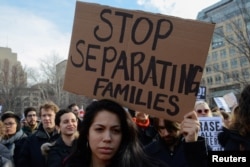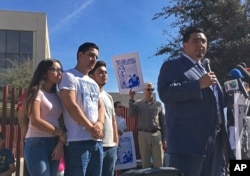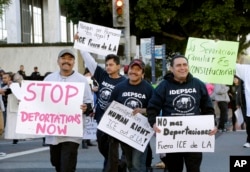The Immigration and Customs Enforcement Agency (ICE) says it rounded up 680 undocumented immigrants last week in enforcement actions in multiple locations around the U.S. This is the first big ICE operation of the Donald Trump presidency, and it has sparked a lot of fear and questions.
What actually happened?
During the week of February 6, ICE launched a “series of targeted enforcement operations across the country,” Department of Homeland Security (DHS) Secretary John Kelly said in a release. More than 680 undocumented people were taken into custody by ICE in Los Angeles, Chicago, Atlanta, San Antonio and New York City. There also were reports of arrests in other locations.
DHS is the parent agency of ICE.
Who was targeted?
Kelly said the action was aimed at “individuals who pose a threat to public safety, border security or the integrity of our nation’s immigration system.” Of those arrested, approximately 75 percent were “criminal aliens.”
Why were the media reports so much more dramatic than DHS’ version?
Over the course of that week, immigrant protection groups got an unusual number of calls from panicking immigrants reporting arrests in homes and at workplaces. A number of groups, led by United We Dream, held a press call February 10, alerting the media to what they said was a new era of persecution under Trump. They shared reports of roadside checkpoints and apartment building sweeps.
Angelica Salas, executive director of the Coalition for Humane Immigrant Rights of Los Angeles (CHIRLA), told reporters that she has had 30 years' experience working with ICE and that the operations that week were "not normal."
But the evidence provided by hers and other groups was largely anecdotal.
The call led to reports in major media outlets with headlines such as "Reports of Raids Have Immigrants Bracing for Enforcement Surge" and "Reports of Immigration Raids Whip Across Texas."
Amid the flurry of reports, ICE and DHS felt compelled to issue a number of statements, stressing that the enforcement operations were routine. “ICE conducts these kind of targeted enforcement operations regularly and has for many years,” Kelly said.
What set the stage for this?
One of Trump’s signature campaign promises was to crack down on illegal immigration, promising to deport up to 3 million people involved in criminal activity. He tweeted on February 12 that he is doing just that. “The crackdown on illegal criminals is merely the keeping of my campaign promise.”
In the first week of his presidency, he signed an executive order called “Enhancing Public Safety in the Interior of the United States.” The order expanded the definition of who was deportable, making it easier to send undocumented immigrants back to their countries of origin. As a result, widespread deportations were expected and feared.
Reports of the deportation of the mother of two American children further fueled fears. Guadalupe Garcia de Rayos, 36, went in for a routine check with ICE on February 8. She had checked in with immigration authorities every year since 2008, when she was stopped for using a fake Social Security number. In past visits, she answered questions that were put to her and went home. This time she was taken into custody.
Was this round-up routine?
To show that this roundup was routine, ICE pointed to several nationwide enforcement operations, often called Operation Cross Check, it has conducted since 2011. President Obama issued guidelines that year specifying that removal efforts should be focused on people who were a threat to public safety.
The operations include:
- March 2015 – National Cross Check operation that resulted in 2,059 arrests nationwide;
- August 2013 – National fugitive enforcement operation resulting in 1,660 arrests, including 1,517 convicted criminals;
- April 2012 – National Cross Check operation that resulted in more than 3,100 arrests;
- September 2011 – National Cross Check operation resulting in the arrest of more than 2,900 convicted criminal aliens;
- June 2011 – National Cross Check operation that resulted in more than 2,400 arrests across all 50 states.
Were there indications that these operations were not routine?
Yes. While there were no checkpoints and whole apartment houses weren’t raided, there were differences that point to changes in deportation policy.
When Secretary Kelly said that 75 percent of the people apprehended in the enforcement operation had criminal records, he also was saying that a quarter of the people picked up were not criminals. That those people were apprehended, likely caught up in a net thrown for someone else, was a break with the past.
During the Obama administration, ICE was instructed to pick up only people who were targeted in advance and not just anybody swept up in a raid. This time seems to have been different.
For example, among those arrested in the ICE roundup was DACA recipient Daniel Ramirez Medina, 23, who was caught in a raid at his father’s Seattle, Washington, house, targeting a “prior deported felon,” according to ICE. Not only was Medina a collateral arrest, but under Obama’s Deferred Action for Childhood Arrivals (DACA), a program protecting young people who came to the U.S. as children, he had a legal work permit. Lawyers have filed suit on his behalf.
Another area where there seems to have been a change in policy is an Obama-era rule that ICE agents would only target deportation orders dating from the beginning of 2014. Rayos, mentioned above, would have had a deportation order dating from 2008.
And finally, if DHS is targeting “criminal aliens,” there is the question of what that means in the Trump era. His executive order would indicate the bar has moved. A DHS official indicated just how far by telling the Washington Post that a “criminal alien” includes “anyone who had entered the United States illegally or overstayed or violated the terms of a visa.”
Some 11 million people in the United States are in that group.
What now?
Pro-immigrant groups believe the roundups were intended to strike fear into the heart of the immigrant community, and that they have succeeded.
The Congressional Hispanic Caucus has requested guidance from ICE Acting Director Thomas Homan. Without it, the caucus said in a letter, "our communities will be paralyzed as students will remain home from school, parents will be afraid to leave children alone, and our local economies will be irreparably damaged."











